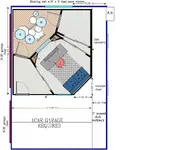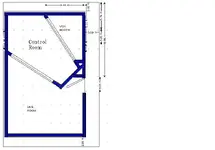There are a couple of problems going the way you plan, as far as best isolation for dollar spent. One - the best use of materials is to have two, and only two, leaves of mass between the two areas to be isolated (in one case, that's between you and the world - in the other case, it's between CR and tracking room or iso room. This is true of ceilings also, and floors if you want to get technical.
Your plan on interior walls having identical leaves on both sides will be a mistake as well - even if this construction didn't equal a "4-leaf wall", (your outer double leaf wall and your inner, double leaf wall) you STILL don't want both leaves of any wall to be identical to each other. Doing that means that whatever frequencies get through one side will also get through the other side. This is why you need to change one leaf by either adding an extra layer, preferably different thickness, or by using two 5/8 on one side and one each of 5/8 and 1/2 on the other.
I just ran some calculations on a wall with one 1/2" sheetrock on the outside (my freebie calc only does sheet rock) and two 5/8" layers on the inside, on separate frames, with a 36" air gap (like your hallway down the one side) and it comes up with STC 59, with its mass-air-mass resonance clear down to 26 hZ - this would be a very good wall - its Transmission loss clear down to 50 hZ is still 32 dB, which equates to probably 70 dB when you figure in the Fletcher-Munson curve of human hearing response -
If I were you, I'd consider doing some of John's "inside out" walls for at least that side of the enclosure - you'll get extra absorption, almost zero loss of air space (percentage-wise) . Since your outside frame already has wallboard on the inner side, I would temporarily leave it (at least on the side where you can get at it after the room is constructed) - then, I would build your inner walls with wallboard only on the outside of the frame, and run some leakage tests (a live drummer helps for this, as will a sound level meter - the Radio shack analog one is fine for this as well as a good tool just to have around ) - then, if you're not happy with the isolation you can remove the wallboard from your outer frame and replace it with pegboard (to protect the insulation, and to eliminate that "leaf" acoustically) and add 1 or 2 more layers on the studio wall (but only on the one side of the frame, not both)
For the walls that do NOT have room to work, you'll want to get rid of the inner wallboard (it can be replaced with pegboard if need be, to protect insulation without becoming another "leaf") before putting up your new frames, then put wallboard ONLY on one side of the new frame. When drawing this, keep the construction so that sound always has to travel through two separate mass centers to get through, no matter where it goes.
This can be a real bitch to get right, but the end result has been lab-tested, and the exact same amount of materials can yield up to 23 dB more (or less) sound isolation just by where they are placed, in the exact same framing. It's worth getting it right the first time. If you have more questions on this, I'll be around... Steve




